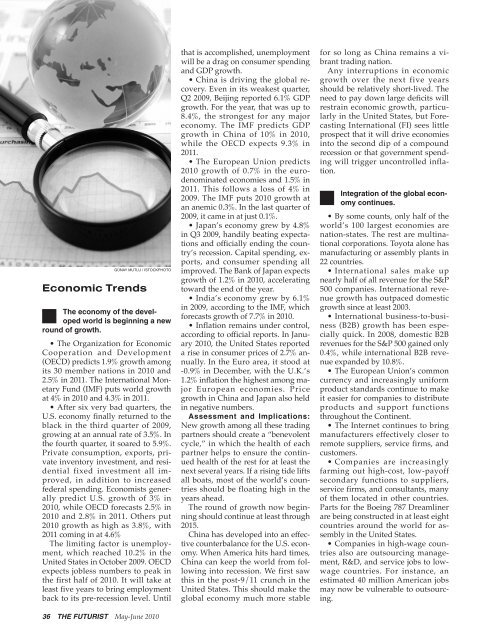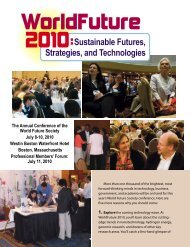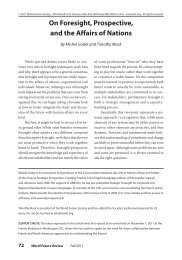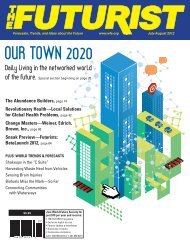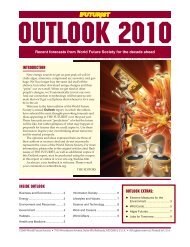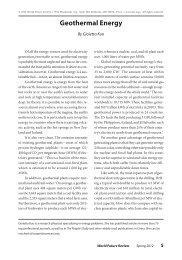Trends Shaping Tomorrow's - World Future Society
Trends Shaping Tomorrow's - World Future Society
Trends Shaping Tomorrow's - World Future Society
You also want an ePaper? Increase the reach of your titles
YUMPU automatically turns print PDFs into web optimized ePapers that Google loves.
Economic <strong>Trends</strong><br />
■<br />
GÜNAY MUTLU / ISTOCKPHOTO<br />
The economy of the developed<br />
world is beginning a new<br />
round of growth.<br />
• The Organization for Economic<br />
Cooperation and Development<br />
(OECD) predicts 1.9% growth among<br />
its 30 member nations in 2010 and<br />
2.5% in 2011. The International Monetary<br />
Fund (IMF) puts world growth<br />
at 4% in 2010 and 4.3% in 2011.<br />
• After six very bad quarters, the<br />
U.S. economy finally returned to the<br />
black in the third quarter of 2009,<br />
growing at an annual rate of 3.5%. In<br />
the fourth quarter, it soared to 5.9%.<br />
Private consumption, exports, private<br />
inventory investment, and residential<br />
fixed investment all improved,<br />
in addition to increased<br />
federal spending. Economists generally<br />
predict U.S. growth of 3% in<br />
2010, while OECD forecasts 2.5% in<br />
2010 and 2.8% in 2011. Others put<br />
2010 growth as high as 3.8%, with<br />
2011 coming in at 4.6%<br />
The limiting factor is unemployment,<br />
which reached 10.2% in the<br />
United States in October 2009. OECD<br />
expects jobless numbers to peak in<br />
the first half of 2010. It will take at<br />
least five years to bring employment<br />
back to its pre-recession level. Until<br />
36 THE FUTURIST May-June 2010<br />
that is accomplished, unemployment<br />
will be a drag on consumer spending<br />
and GDP growth.<br />
• China is driving the global recovery.<br />
Even in its weakest quarter,<br />
Q2 2009, Beijing reported 6.1% GDP<br />
growth. For the year, that was up to<br />
8.4%, the strongest for any major<br />
economy. The IMF predicts GDP<br />
growth in China of 10% in 2010,<br />
while the OECD expects 9.3% in<br />
2011.<br />
• The European Union predicts<br />
2010 growth of 0.7% in the eurodenominated<br />
economies and 1.5% in<br />
2011. This follows a loss of 4% in<br />
2009. The IMF puts 2010 growth at<br />
an anemic 0.3%. In the last quarter of<br />
2009, it came in at just 0.1%.<br />
• Japan’s economy grew by 4.8%<br />
in Q3 2009, handily beating expectations<br />
and officially ending the country’s<br />
recession. Capital spending, exports,<br />
and consumer spending all<br />
improved. The Bank of Japan expects<br />
growth of 1.2% in 2010, accelerating<br />
toward the end of the year.<br />
• India’s economy grew by 6.1%<br />
in 2009, according to the IMF, which<br />
forecasts growth of 7.7% in 2010.<br />
• Inflation remains under control,<br />
according to official reports. In January<br />
2010, the United States reported<br />
a rise in consumer prices of 2.7% annually.<br />
In the Euro area, it stood at<br />
-0.9% in December, with the U.K.’s<br />
1.2% inflation the highest among major<br />
European economies. Price<br />
growth in China and Japan also held<br />
in negative numbers.<br />
Assessment and Implications:<br />
New growth among all these trading<br />
partners should create a “benevolent<br />
cycle,” in which the health of each<br />
partner helps to ensure the continued<br />
health of the rest for at least the<br />
next several years. If a rising tide lifts<br />
all boats, most of the world’s countries<br />
should be floating high in the<br />
years ahead.<br />
The round of growth now beginning<br />
should continue at least through<br />
2015.<br />
China has developed into an effective<br />
counterbalance for the U.S. economy.<br />
When America hits hard times,<br />
China can keep the world from following<br />
into recession. We first saw<br />
this in the post-9/11 crunch in the<br />
United States. This should make the<br />
global economy much more stable<br />
for so long as China remains a vibrant<br />
trading nation.<br />
Any interruptions in economic<br />
growth over the next five years<br />
should be relatively short-lived. The<br />
need to pay down large deficits will<br />
restrain economic growth, particularly<br />
in the United States, but Forecasting<br />
International (FI) sees little<br />
prospect that it will drive economies<br />
into the second dip of a compound<br />
recession or that government spending<br />
will trigger uncontrolled inflation.<br />
■<br />
Integration of the global economy<br />
continues.<br />
• By some counts, only half of the<br />
world’s 100 largest economies are<br />
nation-states. The rest are multinational<br />
corporations. Toyota alone has<br />
manufacturing or assembly plants in<br />
22 countries.<br />
• International sales make up<br />
nearly half of all revenue for the S&P<br />
500 companies. International revenue<br />
growth has outpaced domestic<br />
growth since at least 2003.<br />
• International business-to-business<br />
(B2B) growth has been especially<br />
quick. In 2008, domestic B2B<br />
revenues for the S&P 500 gained only<br />
0.4%, while international B2B revenue<br />
expanded by 10.8%.<br />
• The European Union’s common<br />
currency and increasingly uniform<br />
product standards continue to make<br />
it easier for companies to distribute<br />
products and support functions<br />
throughout the Continent.<br />
• The Internet continues to bring<br />
manufacturers effectively closer to<br />
remote suppliers, service firms, and<br />
customers.<br />
• Companies are increasingly<br />
farming out high-cost, low-payoff<br />
secondary functions to suppliers,<br />
service firms, and consultants, many<br />
of them located in other countries.<br />
Parts for the Boeing 787 Dreamliner<br />
are being constructed in at least eight<br />
countries around the world for assembly<br />
in the United States.<br />
• Companies in high-wage countries<br />
also are outsourcing management,<br />
R&D, and service jobs to lowwage<br />
countries. For instance, an<br />
estimated 40 million American jobs<br />
may now be vulnerable to outsourcing.


